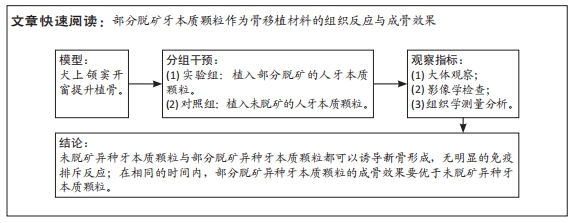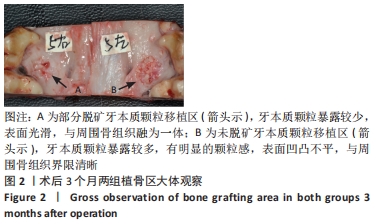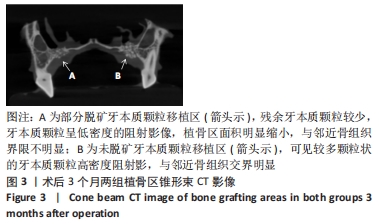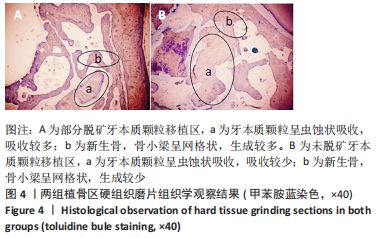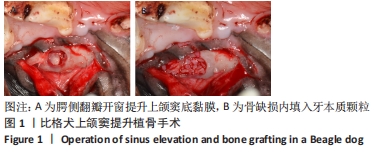[1] BEAMAN FD, BANCROFT LW, PETERSON JJ, et al. Bone graft materials and synthetic substitutes. Radiol Clin North Am. 2006;44(3):451-461.
[2] GARCIA-JÚNIOR IR, SOUZA FÁ, FIGUEIREDO AAS, et al. Maxillary Alveolar Ridge Atrophy Reconstructed With Autogenous Bone Graft Harvested From the Proximal Ulna. J Craniofac Surg. 2018;29(8):2304-2306.
[3] SAKKAS A, WILDE F, HEUFELDER M, et al. Autogenous bone grafts in oral implantology-is it still a “gold standard”? A consecutive review of 279 patients with 456 clinical procedures. Int J Implant Dent. 2017; 3(1):23.
[4] 王宁,崔婷婷,李永奇,等.自体块状皮质骨修复种植区颌骨缺损[J].中国组织工程研究,2020,24(17):2675-2679.
[5] ROGERS GF, GREENE AK. Autogenous bone graft: basic science and clinical implications. J Craniofac Surg. 2012;23(1):323-327.
[6] YOSHIDA T, VIVATBUTSIRI P, MORRISS-KAY G, et al. Cell lineage in mammalian craniofacial mesenchyme. Mech Dev. 2008;125(9-10): 797-808.
[7] KABIR MA, MURATA M, AKAZAWA T, et al. Evaluation of perforated demineralized dentin scaffold on bone regeneration in critical-size sheep iliac defects. Clin Oral Implants Res. 2017;28(11):e227-e235.
[8] LEI G, WANG Y, YU Y, et al. Dentin-Derived Inorganic Minerals Promote the Osteogenesis of Bone Marrow-Derived Mesenchymal Stem Cells: Potential Applications for Bone Regeneration. Stem Cells Int. 2020;(2):1-16.
[9] YEOMANS JD, URIST MR. Bone induction by decalcified dentine implanted into oral, osseous and muscle tissues. Arch Oral Biol. 1967; 12(8):999-1008.
[10] UM IW, KU JK, LEE BK, et al. Postulated release profile of recombinant human bone morphogenetic protein-2 (rhBMP-2) from demineralized dentin matrix. J Korean Assoc Oral Maxillofac Surg. 2019;45(3):123-128.
[11] ZHANG S, LI X, QI Y, et al. Comparison of Autogenous Tooth Materials and Other Bone Grafts. Tissue Eng Regen Med. 2021;18(3):327-341.
[12] ATIYA BK, SHANMUHASUNTHARAM P, HUAT S, et al. Liquid nitrogen-treated autogenous dentin as bone substitute: an experimental study in a rabbit model. Int J Oral Maxillofac Implants. 2014;29(2):e165-170.
[13] REIS-FILHO CR, SILVA ER, MARTINS AB, et al. Demineralised human dentine matrix stimulates the expression of VEGF and accelerates the bone repair in tooth sockets of rats. Arch Oral Biol. 2012;57(5):469-476.
[14] 肖闻澜,胡琛,荣圣安,等.自体牙本质作为骨移植材料的临床应用进展[J].口腔疾病防治,2020(6):394-398.
[15] KOGA T, MINAMIZATO T, KAWAI Y, et al. Bone Regeneration Using Dentin Matrix Depends on the Degree of Demineralization and Particle Size. PLoS One. 2016;11(1):e0147235.
[16] BALDWIN P, LI DJ, AUSTON DA, et al. Autograft, allograft, and bone graft substitutes: clinical evidence and indications for use in the setting of orthopaedic trauma surgery. J Orthop Trauma. 2019;33(4):203-213.
[17] KIM Y, NOWZARI H, RICH SK. Risk of prion disease transmission through bovine-derived bone substitutes: a systematic review. Clin Implant Dent Relat Res. 2013;15(5):645-653.
[18] TAYLOR JC, CUFF SE, LEGER JP, et al. In vitro osteoclast resorption of bone substitute biomaterials used for implant site augmentation: a pilot study. Int J Oral Maxillofac Implants. 2002;17(3):321-330.
[19] GIANNOUDIS P, DINOPOULOS H, TSIRIDIS E. Bone Substitutes: An Update. Injury. 2005;36 Suppl 3(3):S20-27.
[20] KIM YK, KIM SG, YUN PY, et al. Autogenous teeth used for bone grafting: A comparison with traditional grafting materials. Oral Surg Oral Med Oral Pathol Oral Radiol. 2014;117:39-45.
[21] KOZUMA W, KON K, KAWAKAMI S, et al. Osteoconductive potential of a hydroxyapatite fiber material with magnesium: In vitro and in vivo studies. Dent Mater J. 2019;38:771-778.
[22] MURATA M, AKAZAWA T, MITSUGI M, et al. Autograft of Dentin Materials for Bone Regeneration. Advances in Biomaterials Science and Biomedical Applications. 2013:391-403.
[23] Um IW. Demineralized Dentin Matrix (DDM) As a Carrier for Recombinant Human Bone Morphogenetic Proteins (rhBMP-2). Adv Exp Med Biol. 2018;1077:487-499.
[24] Um IW, Ku JK, Kim YK, et al. Histological Review of Demineralized Dentin Matrix as a Carrier of rhBMP-2. Tissue Eng Part B Rev. 2020; 26(3):284-293.
[25] BESSHO K, TAGAWA T, MURATA M. Purification of bone morphogenetic protein derived from bovine bone matrix. Biochem Biophys Res Commun. 1989;165(2):595-601.
[26] ZHANG S, LI X, QI Y, et al. Comparison of Autogenous Tooth Materials and Other Bone Grafts. Tissue Eng Regen Med. 2021;18(3):327-341.
[27] SUN Y, LU Y, CHEN L, et al. DMP1 processing is essential to dentin and jaw formation. J Dent Res. 2011;90(5):619-624.
[28] SINGH A, GILL G, KAUR H, et al. Role of osteopontin in bone remodeling and orthodontic tooth movement: a review. Prog Orthod. 2018;19(1):18.
[29] KIM YK, KIM SG, BYEON JH, et al. Development of a novel bone grafting material using autogenous teeth. Oral Surg Oral Med Oral Pathol Oral Radiol Endod. 2010;109(4):496-503.
[30] 靳夏莹,仲维剑,马国武.自体牙制成骨移植材料在上前牙即刻种植中的应用1例[J].口腔医学研究,2017(11):1228-1229.
[31] 崔婷婷,寇霓,仲维剑,等.自体牙本质颗粒联合富血小板纤维蛋白在上颌窦提升同期种植中的应用[J]. 口腔医学研究,2018,34(5): 532-534.
[32] 崔婷婷,邱泽文,邵阳,等.异种牙本质颗粒复合骨髓浓缩物在上颌窦提升中的成骨效应[J].中国组织工程研究,2018,22(30):4806-4811.
[33] 赵彬彬,仲维剑,马国武.牙本质作为骨移植材料的研究进展[J].国际口腔医学杂志,2021,48(1):82-89.
[34] 赵彬彬,邱泽文,马程辉,等.不同处理方法对未脱钙异种牙本质颗粒成骨性能的影响[J].中国组织工程研究,2019,23(26):4154-4159.
[35] LI R, GUO W, YANG B, et al. Human treated dentin matrix as a natural scaffold for complete human dentin tissue regeneration.Biomater. 2011;32(20):4523-4538.
[36] KIM YK, KIM SG, OH JS, et al. Analysis of the inorganic component of autogenous tooth bone graft material. J Nanosci Nanotechnol. 2011;11(8):7442-7445.
[37] GALLER KM, BUCHALLA W, HILLER KA, et al. Influence of root canal disinfectants on growth factor release from dentin. J Endod. 2015; 41(3):363-368.
[38] MATHEWS S, BHONDE R, GUPTA PK, et al. Novel biomimetic tripolymer scaffolds consisting of chitosan, collagen type 1, and hyaluronic acid for bone marrow-derived human mesenchymal stem cells-based bone tissue engineering. J Biomed Mater Res B Appl Biomater. 2014;102(8):1825-1834.
[39] CHU C, DENG J, SUN X, et al. Collagen Membrane and Immune Response in Guided Bone Regeneration: Recent Progress and Perspectives. Tissue Eng Part B Rev. 2017;23(5):421-435.
[40] REDDI AH. Bone matrix in the solid state:geometric infl uence on differentiation of fibroblasts. Adv Biol Med Phys. 1974;15:1-18.
[41] GUO W, HE Y, ZHANG X, et al. The use of dentin matrix scaffold and dental follicle cells for dentin regeneration. Biomaterials. 2009;30(35): 6708-6723.
[42] LI R, GUO W, YANG B, et al. Human treated dentin matrix as a natural scaffold for complete human dentin tissue regeneration. Biomaterials. 2011;32(20):4525-4538.
[43] MINAMIZATO T, KOGA T, I T, et al. Clinical application of autogenous partially demineralized dentin matrix prepared immediately after extraction for alveolar bone regeneration in implant dentistry: a pilot study. Int J Oral Maxillofac Surg. 2018;47(1):125-132.
|
